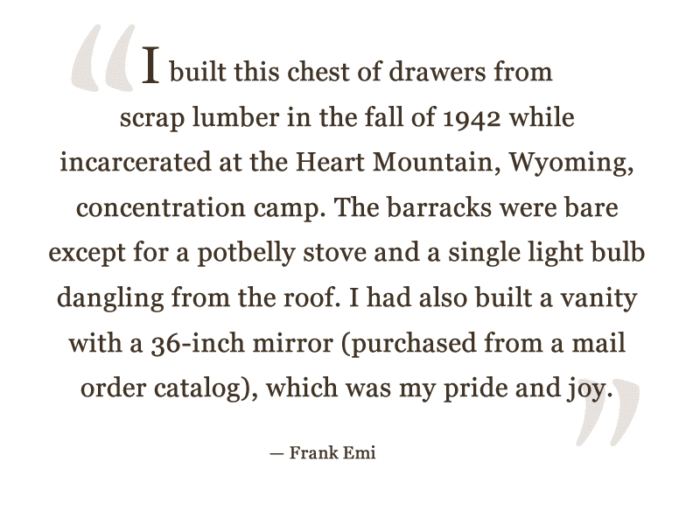Heart Mountain
Location: Cody, Wyo.
Peak population: 10,767
Date opened: August 12, 1942
Date closed: November 10, 1945
Heart Mountain held people from Los Angeles, Santa Clara, and San Francisco, California; Yakima, Washington; and Oregon state.
It occupied 46,000 acres of open sagebrush desert in Park County in northwest Wyoming, 12 miles northeast of Cody. Heart Mountain, 8 miles to the west, created a dramatic backdrop for the camp, which sat at 4,700 feet of elevation near the Shoshone River. Dust storms were common and winters were severe, with lows dipping to 30 degrees below zero.
The Heart Mountain War Relocation Center is best known for the action taken by the Fair Play Committee and the Heart Mountain Draft Resisters, who highlighted the injustice of the incarceration by reminding us of the suspended constitutional rights of the American citizens who were forcibly imprisoned there.
For more info about Heart Mountain, click here.
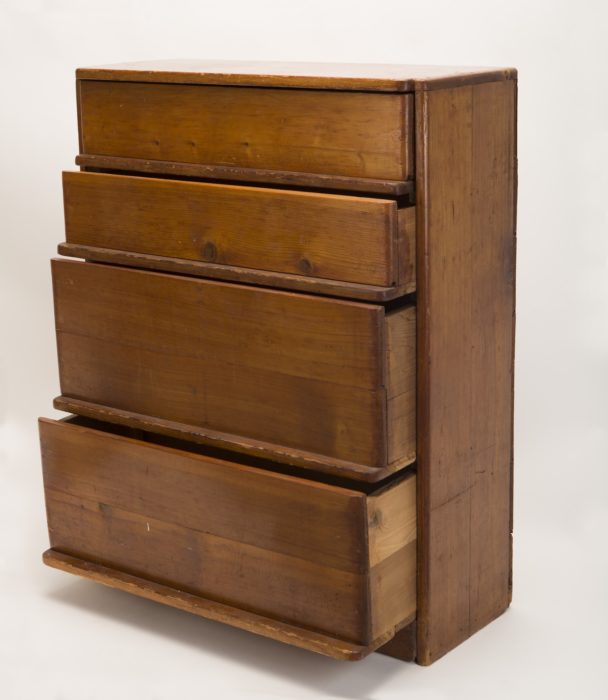
Japanese American National Museum, Gift of Frank S. Emi (2003.294.1)
Click to open full-size image in new tab.This object is part of the story Pride and Joy, which is about Dignity.
- What is this a picture of?
- What is it made out of?
- Does it look handmade or store-bought?
- What tells you that?
This object is part of the story Pride and Joy, which is about Dignity.
Read this quotation by Frank S. Emi, the maker of the chest of drawers.
- What does this quotation tell you about Mr. Emi?
- What does it tell you about the conditions at Heart Mountain?
- What does it tell you about the resources available to those incarcerated at Heart Mountain?

Japanese American National Museum, Gift of Frank S. Emi (96.109.34)
Click to open full-size image in new tab.This object is part of the story Pride and Joy, which is about Dignity.
This is a photograph of Mr. Emi with the vanity he described as his “pride and joy.” The back of the photograph indicates the furniture pictured was made at Heart Mountain concentration camp.
- How would you describe his expression?
- What else do you see in this photograph?
- Without the inscription on the back, would you know where this photograph was taken?
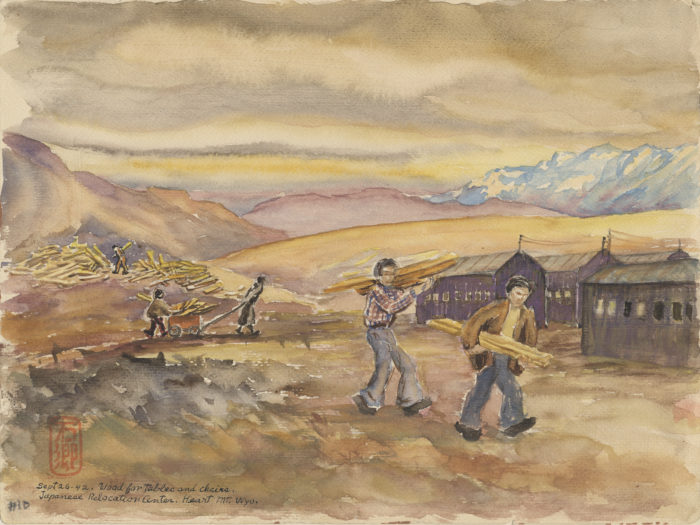
Estelle Ishigo, Untitled (Sept 26-42. Wood for tables and chairs. Japanese Relocation Center. Heart Mt., Wyo.), 1942, watercolor on paper, Japanese American National Museum (94.195.30)
Click to open full-size image in new tab.This object is part of the story Pride and Joy, which is about Dignity.
- What do you see in this image?
- Where was this image painted?
- What are the people doing?
- What evidence can you find that tells you what is happening in this painting?
This is a watercolor painting by a Caucasian woman named Estelle Ishigo. Estelle lived at Heart Mountain along with her husband, Arthur. While there, she drew and painted many of her experiences, giving us a view into daily life at the camp.
Japanese American families were removed from their homes and permitted to bring only what they could carry. Despite this, there were some intangible things that could not be taken away from the Japanese Americans.
- Which ones are depicted in this painting?

Japanese American National Museum, Gift of Frank S. Emi (96.109.27)
Click to open full-size image in new tab.This object is part of the story Wyoming's Largest Mass Trial, which is about Citizenship.
Look closely at this photograph taken in Federal District Court in Cheyenne, Wyoming, in 1944.
- How old might the men depicted here be?
- What do they communicate to you with their expressions and body language?
- Why might so many of them have been in court?
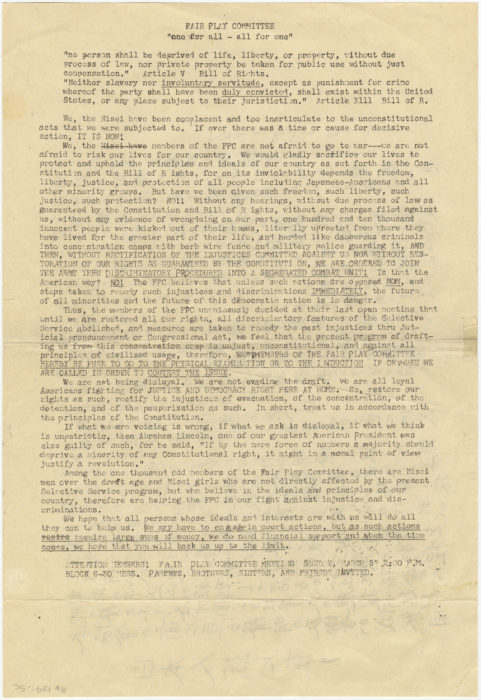
Fair Play Committee bulletin, 1944, Japanese American National Museum, Gift of Frank S. Emi (96.109.5C)
Click to open full-size image in new tab.This object is part of the story Wyoming's Largest Mass Trial, which is about Citizenship.
The young men in the photograph were members of the Fair Play Committee (FPC), and this document is one of their bulletins. Look closely at it.
- What is it called?
- Which parts of the Bill of Rights does it quote?
At the Heart Mountain War Relocation Center in Wyoming, the FPC formed under the leadership of Kiyoshi Okamoto. Growing to nearly 60 members, the FPC represented the most organized response to the military draft among the 10 camps. In addition to paying a $2 fee, FPC members had to affirm that they were US citizens, loyal to the United States and willing to serve in the US Army upon restoration of their legal rights. In other words, the FPC advocated that incarceration violated the constitutional rights of its members, US citizens who would gladly fight in the military upon restoration of their freedom and civil liberties.
The end of the second paragraph of this document states:
The FPC believes that unless such actions are opposed NOW, and steps taken to remedy such injustices and discrimination IMMEDIATELY, the future of all minorities and the future of this democratic nation is in danger.
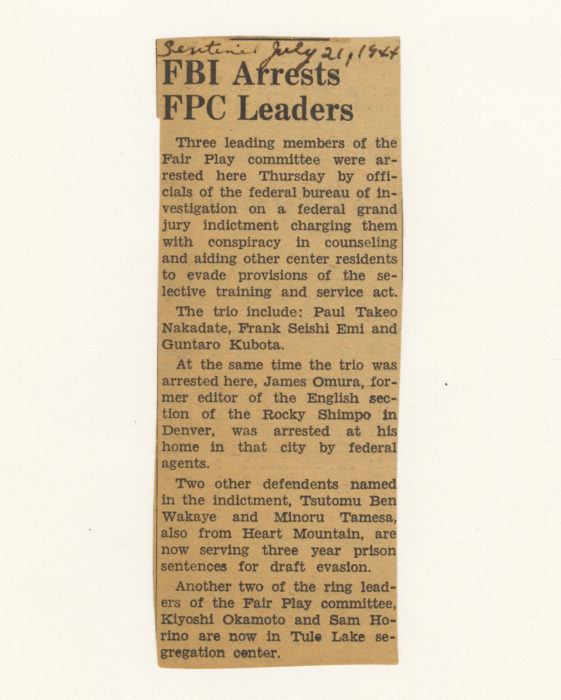
Japanese American National Museum, Gift of Frank S. Emi (96.109.20)
Click to open full-size image in new tab.This object is part of the story Wyoming's Largest Mass Trial, which is about Citizenship.
As you can see from this newspaper clipping, the FBI arrested the leaders of the FPC.
- Is there a clue that might tell you when this event happened?
- What were the names of the people arrested?
Frank S. Emi video interview (May 9, 2006), Japanese American National Museum, DiscoverNikkei.org
Click to open full-size image in new tab.This object is part of the story Wyoming's Largest Mass Trial, which is about Citizenship.
In this video clip, you’ll hear from Frank Emi (1916–2010), one of the leaders of the FPC.
- Does he say he would take the same action again? Why or why not?
Japanese American National Museum, Gift of Eiichi Edward Sakauye (96.147.1)
Click to open full-size image in new tab.This object is part of the story Train Ride to the Unknown, which is about Migration.
Watch this home movie shot by Eiichi Edward Sakauye, who documented inmates arriving at Heart Mountain, Wyoming. Most of the camp’s 10,767 inmates came from California, Washington, and Oregon.
- How did they get to Heart Mountain?
- When they arrived, who was there to greet them?
- How old were the inmates?
- If you were being taken by train to Heart Mountain, what thoughts do you think might be going through your mind?
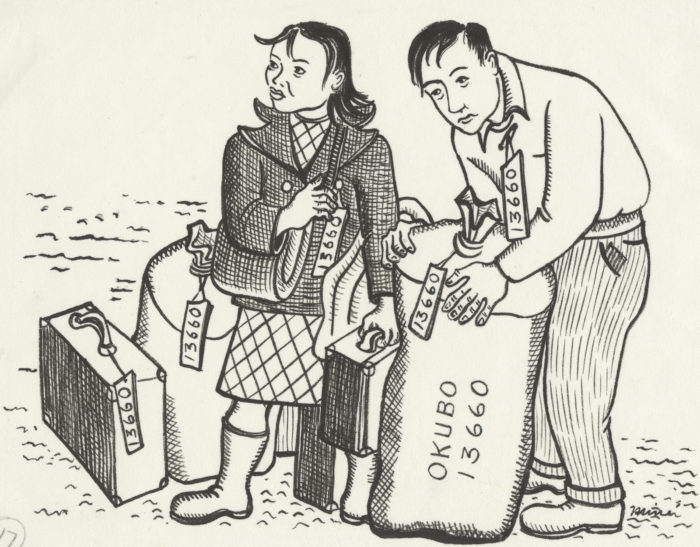
Miné Okubo, Untitled (Miné and Benji standing with their luggage, Berkeley, California, 1942), 1942, ink on paper, Japanese American National Museum, Gift of the Miné Okubo Estate (2007.62.23)
Click to open full-size image in new tab.This object is part of the story Train Ride to the Unknown, which is about Migration.
Look carefully at this drawing of siblings Miné and Benji Okubo.
- What is the first thing you notice?
- How might you describe the expressions on their faces?
- Their last name, Okubo, is written on one bag. What do you think “13660” is? Why do you think that number is everywhere?
The Okubos are waiting with their luggage to be taken away from their home in California. The government assigned them “13660” as their family number, and they have been instructed to pin that number on themselves and to all of their luggage. They do not know it yet, but they will eventually be incarcerated in Topaz, Utah.

Japanese American National Museum, Gift of Mori Shimada (92.10.2AT)
Click to open full-size image in new tab.This object is part of the story Train Ride to the Unknown, which is about Migration.
Look carefully at this photograph taken by Mori Shimada at Heart Mountain in 1945, when World War II was coming to an end and Japanese Americans were beginning to leave camp.
- Have you ever been on a train with so many other people? What was it like?
- What do you think the weather was like on that day?
Japanese American National Museum, Gift of Eiichi Edward Sakauye (96.147.1)
Click to open full-size image in new tab.This object is part of the story Train Ride to the Unknown, which is about Migration.
This home movie clip was taken by Mr. Sakauye as people were leaving Heart Mountain at the end of World War II.
- How can you tell that people are leaving camp?
- How do you think the people leaving might have felt?
- How do you think the people who remained in camp felt?

